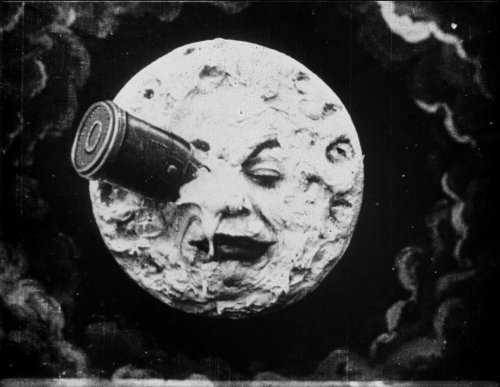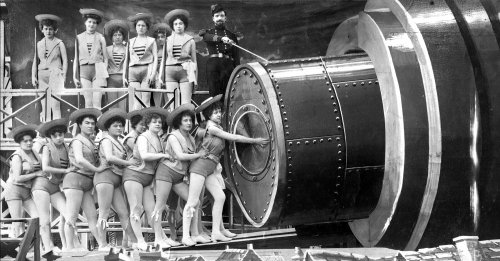 Over a hundred years ago, a Frenchman decided to make a film. Not that unusual, people had been making films for a couple of years by then.
Over a hundred years ago, a Frenchman decided to make a film. Not that unusual, people had been making films for a couple of years by then.
This was different. It wasn’t about an love affair, a strange affair or a light-hearted comedy. This was about a trip to the moon!
This amazing movie, that still stands up today with its effects. These were done by a heavy, fixed camera that advanced the film by a crank on the side.
It has all the Hollywood effects that you would expect in a blockbuster. It had it all apart from making its director any money. More about that later.
The film had it all. Pretty girls in “skimpy” costumes. A well defined story even if it looks a “bit strange” to audiences today. A famous image that everyone will associate with your film or just film in general.
 There are also some strange coincidences with the film and the Apollo space mission of the 1960s.
There are also some strange coincidences with the film and the Apollo space mission of the 1960s.
- Both of the missions launched from Florida
- Both of the capsules that landed were called Columbia
The film can seem a bit disjointed compared to what today we expect to see in a film. What is called the cinematic vocabulary. They were still learning as when the film was made, in 1902, the new art of moving pictures was under a decade old. Storytelling was like a play that was recorded. Specific, almost standalone, scenes then put into order at the end.
It had it all in effects, under, and over, cranked sequences – to make sequences seem faster or slower. Disappearing and reappearing objects. Special effects using models. All done over 110 years ago.
Now comes to the sad part. The film was pirated and made the pirates a huge amount of money that Georges Méliès should have had. It was mainly down to the people that Méliès sold the film to. They just made a copy and sold that on to someone else without giving the creator any of the profits. This is how the print got to America. This is where Thomas Alva Edison enters the story. His company, the Edison Manufacturing Company, got hold of a print and then went to town making copies.
Twelve years later after fighting Edison and his film monopoly, he was declared bankrupt. The only reason he kept his house and studio was the first world war started.
This also meant that a lot of the copies of his films were lost. Not only that, in 1917, the French army melted down a lot to capture the silver to make boot heals from!
Then Méliès burnt all of the remaining negatives of his films. A huge loss to history.
There is a happy ending, of sorts, to this film. When the film was originally released, you could get it in two formats. The black and white original or, for more money, a hand tinted one.
For over 85 years this tinted version was thought to be lost forever until it was rediscovered in 1993 in a donated collection of early films. It was thought to be in a state of decay that would make reconstruction impossible. Fortunately, this was proved wrong and with almost 10 years work, the film was saved. Making the restoration the cinematic highlight of the year and maybe of the century. High praise indeed.
The tinted version is available to watch on Vimeo, or just click play below.








